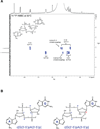The innate immune DNA sensor cGAS produces a noncanonical cyclic dinucleotide that activates human STING
- PMID: 23707065
- PMCID: PMC3706192
- DOI: 10.1016/j.celrep.2013.05.009
The innate immune DNA sensor cGAS produces a noncanonical cyclic dinucleotide that activates human STING
Abstract
The presence of foreign DNA in the cytosol of mammalian cells elicits a potent antiviral interferon response. Recently, cytosolic DNA was proposed to induce the synthesis of cyclic GMP-AMP (cGAMP) upon binding to an enzyme called cGAMP synthase (cGAS). cGAMP activates an interferon response by binding to a downstream receptor called STING. Here, we identify natural variants of human STING (hSTING) that are poorly responsive to cGAMP yet, unexpectedly, are normally responsive to DNA and cGAS signaling. We explain this paradox by demonstrating that the cGAS product is actually a noncanonical cyclic dinucleotide, cyclic [G(2'-5')pA(3'-5')p], which contains a single 2'-5' phosphodiester bond. Cyclic [G(2'-5')pA(3'-5')p] potently activates diverse hSTING receptors and, therefore, may be a useful adjuvant or immunotherapeutic. Our results indicate that hSTING variants have evolved to distinguish conventional (3'-5') cyclic dinucleotides, known to be produced mainly by bacteria, from the noncanonical cyclic dinucleotide produced by mammalian cGAS.
Copyright © 2013 The Authors. Published by Elsevier Inc. All rights reserved.
Figures




References
Publication types
MeSH terms
Substances
Associated data
- Actions
Grants and funding
LinkOut - more resources
Full Text Sources
Other Literature Sources
Molecular Biology Databases
Research Materials

